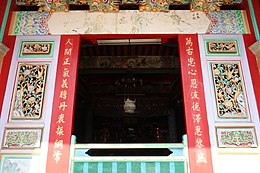In Chinese poetry, a duilian (simplified Chinese: 对联; traditional Chinese:
| Duilian | |||||||||||||||||||||||||
|---|---|---|---|---|---|---|---|---|---|---|---|---|---|---|---|---|---|---|---|---|---|---|---|---|---|
 | |||||||||||||||||||||||||
| Chinese name | |||||||||||||||||||||||||
| Traditional Chinese | |||||||||||||||||||||||||
| Simplified Chinese | 对联 | ||||||||||||||||||||||||
| |||||||||||||||||||||||||
| Vietnamese name | |||||||||||||||||||||||||
| Vietnamese alphabet | Đối liên Câu đối | ||||||||||||||||||||||||
| Chữ Hán | |||||||||||||||||||||||||
| Chữ Nôm | |||||||||||||||||||||||||
| Japanese name | |||||||||||||||||||||||||
| Kanji | |||||||||||||||||||||||||
| Hiragana | ついれん | ||||||||||||||||||||||||
| |||||||||||||||||||||||||
Requirements
editA duilian must adhere to the following rules:
- Both lines must have the same number of Chinese characters.
- The lexical category of each character must be the same as its corresponding character.
- The tone pattern of one line must be the inverse of the other. This generally means if one character is of the level (
平 ) tone, its corresponding character on the other line must be of an oblique (仄) tone. - The last character of the first line should be of an oblique tone, which forces the last character of the second line to be of a level tone.
- The meanings of the two lines must be related, with each pair of corresponding characters having related meanings too.
Example
editExample of a duilian:
書 山 有路 勤 爲 徑 - Tone pattern: level-level-oblique-oblique-level-level-oblique (
平 平仄 仄平平仄 ) - Pinyin: shū shān yǒu lù qín wéi jìng
- Translation: The mountain of books has one way and hard work serves as the path
- Tone pattern: level-level-oblique-oblique-level-level-oblique (
學海 無涯 苦 作 舟 - Tone pattern: oblique-oblique-level-level-oblique-oblique-level (仄仄
平 平仄 仄平) - Pinyin: xué hǎi wú yá kǔ zuò zhōu
- Translation: The sea of learning has no end and effort makes the boat
- Tone pattern: oblique-oblique-level-level-oblique-oblique-level (仄仄
| Bottom | Top | ||
|---|---|---|---|
| knowledge | book | ||
| sea | mountain | ||
| have not | have | ||
| border | 涯 | way | |
| painstaking | diligence | ||
| makes | is | ||
| boat | path |
History and usage
editOriginating during the Five Dynasties, and flourishing during the Ming and Qing dynasties in particular, duilians have a history of more than a thousand years and remain an enduring aspect of Chinese culture.
Often, duilians are written on red paper and stuck on walls. Sometimes, they are carved onto plaques of wood for a more permanent display.
Dueling duilians are a popular pastime with Chinese speakers,[1] a game of verbal and intellectual dexterity, wit, and speed which shares some parallels with the dozens.
See also
edit
Gallery
edit-
Arabic duilian outside Tianshui temple
-
Duilian written by a famous poet at Daguan Park
References and notes
edit- ^ "Chinese Couplets". chinesecouplets.dayabook.com.